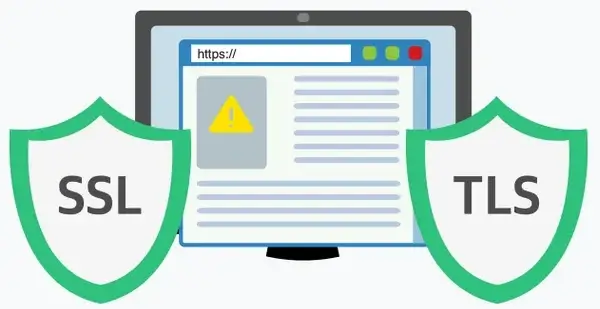
The main difference between SSL and TLS lies in their security improvements and protocol versions. SSL is an older, now obsolete protocol for securing data transmission, while TLS is its more secure and modern successor. TLS offers stronger encryption and improved security features and is the current standard for secure internet communications.
One of the most important considerations if you're seeking maximum security for your website is using encryption protocols.
You have two choices: SSL (secure sockets layer) and TLS (transport layer security). These commonly used protocols encrypt internet communications and protect sensitive website data from malicious attacks.
Let's cover the key differences between SSL and TLS and point you in the right direction for choosing the best protocol for your website.
What Is SSL?
SSL is a security technology that protects data sent between a website and a user's web browser.
Designed to prevent hackers from stealing sensitive information like credit card numbers during online transactions, SSL encrypts data to make sure only the intended recipient can read it. This process makes it more difficult for cybercriminals to intercept and steal information.
What Is TLS?
TLS does the same thing as SSL. However, because it's a newer technology, it typically provides stronger encryption, improved security, and better performance.
Your website requires an SSL or TLS certificate to demonstrate its security to users and reassure them that their transactions and details are safe.
You must ensure your certificates are valid, or you may be a recipient of security warnings, potentially leading to restrictions preventing you from communicating with your website or email server.
Pro Tip: Consider implementing SSL/TLS certificate monitoring services to ensure your SSL/TLS certificates are up-to-date and properly configured.

How TLS and SSL Keep Website Data Safe
An SSL/TLS certificate on your web server has a private and public key that encrypts and decrypts data. When someone visits your website, their browser looks for your SSL/TLS certificate to check if it's valid. This authentication process is known as a "handshake."
If the certificate is invalid, they may see an error message and leave your site. However, the server can deliver data securely if the certificate is valid. This is why HTTPS appears in address bars—to indicate HTTP over SSL/TLS.
HTTP and HTTPS protocols are crucial in transferring online data, but simple HTTP is vulnerable to attacks and interception. HTTPS encrypts and authenticates data while it's in transit, thus ensuring its security.
Paying for goods online with a credit card is only safe and secure when a website uses HTTPS in its address bar, not HTTP, regardless of whether you're using a VPN or not. In addition to using HTTPS, it's essential to ensure your website has strong online payment security measures in place to protect sensitive customer information. Major web browsers encourage adopting HTTPS to protect users' privacy and security.

What's the Difference Between TLS and SSL?
The main difference between TLS and SSL is that TLS is newer and more secure. As SSL's successor, it was initially developed to address SSL vulnerabilities.
While TLS and SSL share many similarities and serve the same purpose (providing secure communication over the internet), there are some key differences between them.
Different Key Exchange Algorithms
TLS uses Diffie-Hellman key exchange. In Diffie-Hellman key exchange, the two parties generate their own public and private keys. They then exchange their public keys and use them to generate a shared secret key that only they know. The shared secret key can be used to encrypt and decrypt messages between the two.
Even if someone intercepts the public keys used in Diffie-Hellman key exchange, they won't be able to figure out the secret key without solving a really hard math problem, making the exchange more secure.
Better Support
TLS has better support for modern cryptographic algorithms than SSL. Moreover, it supports a broader range of ciphers.
For example, TLS 1.2 and 1.3 use stronger codes than SSL, which makes them harder to break. TLS also uses superior methods, like message authentication, to check the information you receive hasn't been tampered with. This process ensures that the information is really coming from the person or website you think it is.
Certificate Authorities
In SSL, certificate authorities (CAs) issue digital certificates that verify the identity of a website. In TLS, CAs play the same role, but there are more strict requirements for issuing certificates to ensure greater security.
Protocol Handshake

We've already covered the server authentication process known as a "handshake." A handshake involves a series of steps to exchange secret codes (called cryptographic keys) that are used to encrypt and decrypt information.
The initial protocol handshake in TLS is different from SSL. TLS 1.3, for example, has reduced the number of round trips required during the handshake, which makes it faster and more secure.
Session Resumption
Session resumption is a way to speed up the secure connection if you revisit the same website in the near future.
When you visit a website for the first time, you often have to wait for the handshake to complete the key exchange and verification steps. But if you revisit the same website within a short period (usually a few hours), the handshake can be skipped or shortened, saving time and reducing server load.
In SSL, session resumption is achieved using session IDs. After the initial handshake, these small codes are stored on your computer and the server. When you revisit the same website, your computer sends the session ID to the server, which can use it to resume the secure connection quickly.
In TLS, resumption can also be achieved using session IDs, but there is a newer method called session tickets as well. These are like small encrypted files that contain the secret codes needed to resume the secure connection.
Your computer stores the session ticket instead of the session ID, and when you revisit the website, this is sent to the server to reactivate the secure connection quickly.
Alert Messages
Alert messages are used to convey error conditions and warnings. For example, vendor remote access solutions, such as RDP (remote desktop protocol) clients, allow users to access a remote server or computer over a network connection.
SSL/TLS helps keep communication between a client and server private and secure by encrypting and authenticating it. The two use alert messages to convey any errors or warning messages during the communication.
Ensuring SSL/TLS is properly configured can help prevent unauthorized users from intercepting screen-sharing data and other sensitive information.
In SSL, alert messages are transmitted without encryption, making them vulnerable to interception by unauthorized parties. On the other hand, TLS encrypts alert messages, which means only the communicating parties can access and read them.

Should Your Website Have TLS or SSL?
The TLS vs. SSL question is similar to asking, "Is RDP secure without VPN?"
As a protocol used for remotely accessing and controlling a computer over a network connection, RDP isn't recommended without additional security measures, such as a VPN.
Similarly, SSL alone isn't recommended for websites without extra security protocols, such as keeping on top of updates, backups, and patches and implementing a web application firewall to protect against certain cyberattacks.
The TLS protocol has replaced SSL because it's faster and more secure. It has several advantages over SSL, including:
- Improved security
- Better compatibility with modern web browsers
- Compliance with industry regulations
- Faster performance
If you're building a new website or planning to update the security of your existing one, it's important to consider the latest technology trends resources. As tech evolves, so do the methods used by cybercriminals to exploit website vulnerabilities. That's why using the most up-to-date security protocols and tools is essential to protect your website and its users.
One of the latest technology trends in website security is implementing TLS 1.3. This version includes new features and improvements like faster handshakes and better performance. Modern web browsers widely support it and can significantly boost your website's security and performance.
Security tip: It's important to note that choosing between SSL and TLS is not the only thing to consider for your website's security. You must also properly configure and maintain your security settings, including regularly updating your security certificates and enforcing secure connections (HTTPS) throughout your website.
Wrapping Up
In conclusion, both TLS and SSL are protocols that authenticate and encrypt data transmission over the internet. While the two are closely related, TLS is essentially the updated and more secure version.
Regardless of your final decision, deploying vulnerability monitoring services is wise. Such services scan your servers and firewalls for thousands of known security issues and exploits and recommend how to protect your systems better.


 Copyright 2000-2025, WebSitePulse. All rights reserved.
Copyright 2000-2025, WebSitePulse. All rights reserved.